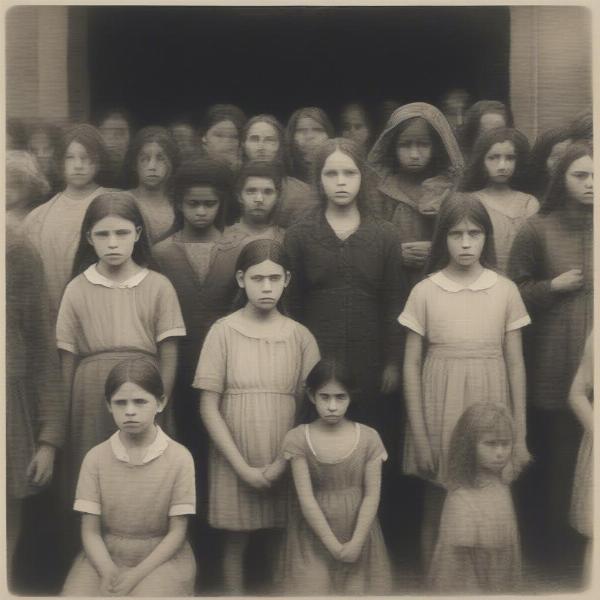The Hunger Games, Suzanne Collins’s dystopian young adult novel series, captivates readers with its thrilling plot and thought-provoking themes. A key element driving the narrative is the age range of the tributes forced to compete. Understanding the ages of the Hunger Games participants is crucial to grasping the gravity of the situation and the inherent cruelty of Panem’s totalitarian regime. This article will delve into the age requirements for the Hunger Games, exploring the significance of this age bracket and the impact it has on the characters and the overarching story.
Understanding the Age Range of Hunger Games Tributes
The Hunger Games mandates that children aged twelve to eighteen are eligible for the annual reaping. This means that as soon as a child turns twelve, they become potential tributes, facing the terrifying possibility of being chosen to fight to the death. This age range, encompassing the vulnerable years of adolescence, underscores the Capitol’s callous disregard for young life. The selection of children during these formative years heightens the sense of injustice and barbarity.
The Significance of the 12-18 Age Bracket
The 12-18 age bracket in the Hunger Games is not arbitrary. It’s a calculated move by the Capitol to instill fear and maintain control. These are the years when young people begin to develop their own sense of identity, question authority, and form bonds of friendship and love. By forcing them to compete in a brutal fight for survival, the Capitol crushes their spirit, making it harder for any rebellion to take root.
The Impact on Character Development
The chosen age range plays a critical role in the development of the characters. Katniss Everdeen, the protagonist, volunteers at the age of sixteen to save her younger sister, Prim, demonstrating extraordinary courage and selflessness. Peeta Mellark, the male tribute from District 12, also falls within this age range, facing the Games with a mixture of fear and determination. Their youth highlights the emotional toll of the Games and underscores the loss of innocence forced upon them.
The Cruelty of the Capitol
The Capitol’s decision to target this age group highlights the regime’s cruelty and disregard for human life. The tributes are not seasoned soldiers or hardened criminals; they are children on the cusp of adulthood, robbed of their future. The Games serve as a chilling reminder of the Capitol’s power and the lengths it will go to maintain its oppressive rule.
 Hunger Games Tribute Age Chart
Hunger Games Tribute Age Chart
The Reaping and its Psychological Impact
The reaping, the process of selecting tributes, further intensifies the impact of the age range. The uncertainty and fear leading up to the reaping cast a dark shadow over the lives of every child within the eligible age bracket. This constant threat of selection creates an environment of anxiety and dread, contributing to the psychological manipulation employed by the Capitol.
The Odds of Being Chosen
The odds of being chosen are not equal for all children. Children from poorer districts, like District 12, often have their names entered multiple times in exchange for tesserae, meager rations of grain and oil. This system further disadvantages the most vulnerable members of society, highlighting the systemic inequalities within Panem.
The Impact on Families
The Hunger Games not only affects the tributes themselves but also devastates their families and communities. The loss of a child, or even the constant fear of losing a child, creates a climate of grief and despair, further cementing the Capitol’s control.
 Hunger Games Reaping Ceremony Scene
Hunger Games Reaping Ceremony Scene
The Hunger Games and Social Commentary
The age range of the tributes is a crucial element of the social commentary embedded within the Hunger Games trilogy. Collins uses the Games as a lens to explore themes of oppression, social inequality, and the abuse of power. The vulnerability of the tributes serves as a powerful indictment of totalitarian regimes and the devastating impact they have on individuals and societies.
Parallels to Child Soldiers
The Hunger Games draws parallels to the real-world issue of child soldiers. While the Games are a fictional construct, they highlight the horrors of forcing children into combat and the long-term psychological consequences they endure.
The Power of Hope and Rebellion
Despite the bleakness of the situation, the Hunger Games also offers a message of hope and rebellion. Katniss Everdeen’s defiance and courage inspire others to question the Capitol’s authority and fight for a better future. The resilience of the human spirit, even in the face of unimaginable adversity, shines through.
Beyond the Arena: Life After the Hunger Games
Even for those who survive the Hunger Games, the trauma and psychological scars remain. The Games forever alter the lives of the victors, leaving them to grapple with the memories of what they have witnessed and the actions they have been forced to take. The age at which they experienced this trauma significantly impacts their ability to cope and rebuild their lives.
Conclusion
The ages for the Hunger Games, specifically the 12-18 age bracket, are a central element of the story, driving the narrative and highlighting the cruelty of the Capitol’s oppressive rule. Understanding this age range allows readers to fully appreciate the gravity of the Games and the social commentary woven throughout the trilogy. By targeting children during these formative years, the Capitol aims to crush their spirit and maintain control. However, the bravery and resilience of characters like Katniss Everdeen offer a glimmer of hope and inspire rebellion against tyranny. The Hunger Games serves as a cautionary tale, reminding us of the importance of protecting the vulnerable and fighting against injustice.
FAQ
- What is the youngest age someone can be chosen for the Hunger Games? Twelve years old.
- What is the oldest age someone can be chosen for the Hunger Games? Eighteen years old.
- Why does the Capitol choose children for the Hunger Games? To maintain control and suppress rebellion.
- How are tributes chosen for the Hunger Games? Through a public lottery called the reaping.
- Can someone volunteer as tribute in the Hunger Games? Yes, but only under specific circumstances, such as to replace a younger sibling.
- What are tesserae in the Hunger Games? Tesserae are tokens exchanged for extra food rations, but they also increase the odds of a child’s name being drawn in the reaping.
- What is the significance of the 12-18 age range in the Hunger Games? It represents the vulnerability of adolescence and the Capitol’s calculated cruelty.

